A Comprehensive Analysis of Propaganda Art and Artistic Movements
VerifiedAdded on 2022/11/25
|10
|3123
|389
Essay
AI Summary
This essay provides a comprehensive analysis of various art movements and their associated concepts. It begins by examining propaganda art examples from the Renaissance, Baroque, Age of Enlightenment, and Modernism, highlighting how art was used to convey specific messages and influence public opinion. The essay then delves into the key tenets of Humanism during the Renaissance and the philosophical underpinnings of Modernism, exploring their impacts on cultural perspectives. Furthermore, it investigates the transformative effects of the Protestant Reformation on art in Northern Europe, including changes in artistic priorities, subject matter, and the emergence of new markets. The essay also explores architectural styles, using St. Petersburg as an example of Baroque architecture, and discusses the Rococo period's influences. It then examines the emergence of Impressionism, focusing on the 'new way of looking' and the impact of artists like Monet and Cezanne. Finally, the essay analyzes the role of Cubism and the rise and fall of Abstract Expressionism, including its impact on art and its relationship with the masses.
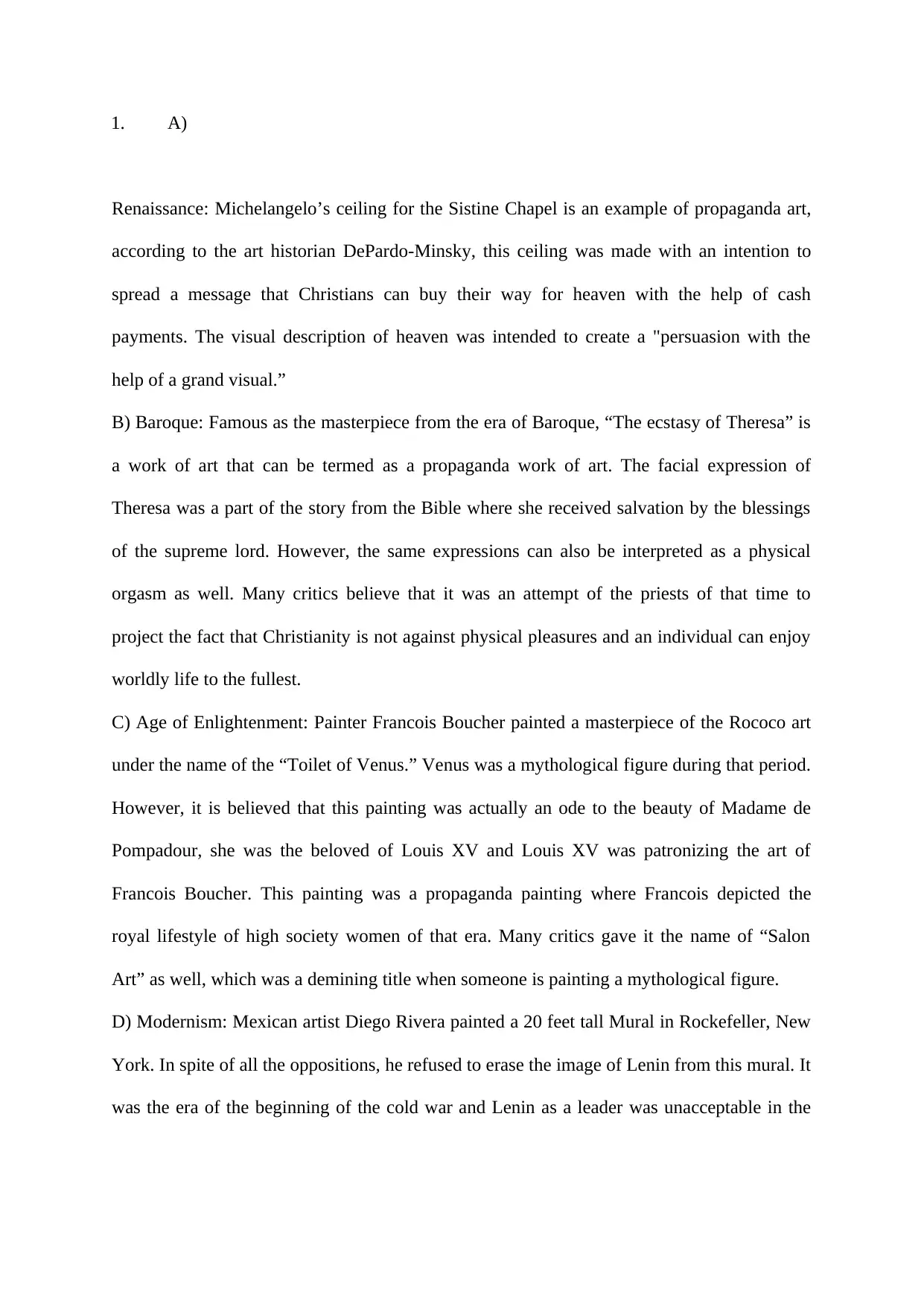
1. A)
Renaissance: Michelangelo’s ceiling for the Sistine Chapel is an example of propaganda art,
according to the art historian DePardo-Minsky, this ceiling was made with an intention to
spread a message that Christians can buy their way for heaven with the help of cash
payments. The visual description of heaven was intended to create a "persuasion with the
help of a grand visual.”
B) Baroque: Famous as the masterpiece from the era of Baroque, “The ecstasy of Theresa” is
a work of art that can be termed as a propaganda work of art. The facial expression of
Theresa was a part of the story from the Bible where she received salvation by the blessings
of the supreme lord. However, the same expressions can also be interpreted as a physical
orgasm as well. Many critics believe that it was an attempt of the priests of that time to
project the fact that Christianity is not against physical pleasures and an individual can enjoy
worldly life to the fullest.
C) Age of Enlightenment: Painter Francois Boucher painted a masterpiece of the Rococo art
under the name of the “Toilet of Venus.” Venus was a mythological figure during that period.
However, it is believed that this painting was actually an ode to the beauty of Madame de
Pompadour, she was the beloved of Louis XV and Louis XV was patronizing the art of
Francois Boucher. This painting was a propaganda painting where Francois depicted the
royal lifestyle of high society women of that era. Many critics gave it the name of “Salon
Art” as well, which was a demining title when someone is painting a mythological figure.
D) Modernism: Mexican artist Diego Rivera painted a 20 feet tall Mural in Rockefeller, New
York. In spite of all the oppositions, he refused to erase the image of Lenin from this mural. It
was the era of the beginning of the cold war and Lenin as a leader was unacceptable in the
Renaissance: Michelangelo’s ceiling for the Sistine Chapel is an example of propaganda art,
according to the art historian DePardo-Minsky, this ceiling was made with an intention to
spread a message that Christians can buy their way for heaven with the help of cash
payments. The visual description of heaven was intended to create a "persuasion with the
help of a grand visual.”
B) Baroque: Famous as the masterpiece from the era of Baroque, “The ecstasy of Theresa” is
a work of art that can be termed as a propaganda work of art. The facial expression of
Theresa was a part of the story from the Bible where she received salvation by the blessings
of the supreme lord. However, the same expressions can also be interpreted as a physical
orgasm as well. Many critics believe that it was an attempt of the priests of that time to
project the fact that Christianity is not against physical pleasures and an individual can enjoy
worldly life to the fullest.
C) Age of Enlightenment: Painter Francois Boucher painted a masterpiece of the Rococo art
under the name of the “Toilet of Venus.” Venus was a mythological figure during that period.
However, it is believed that this painting was actually an ode to the beauty of Madame de
Pompadour, she was the beloved of Louis XV and Louis XV was patronizing the art of
Francois Boucher. This painting was a propaganda painting where Francois depicted the
royal lifestyle of high society women of that era. Many critics gave it the name of “Salon
Art” as well, which was a demining title when someone is painting a mythological figure.
D) Modernism: Mexican artist Diego Rivera painted a 20 feet tall Mural in Rockefeller, New
York. In spite of all the oppositions, he refused to erase the image of Lenin from this mural. It
was the era of the beginning of the cold war and Lenin as a leader was unacceptable in the
Paraphrase This Document
Need a fresh take? Get an instant paraphrase of this document with our AI Paraphraser
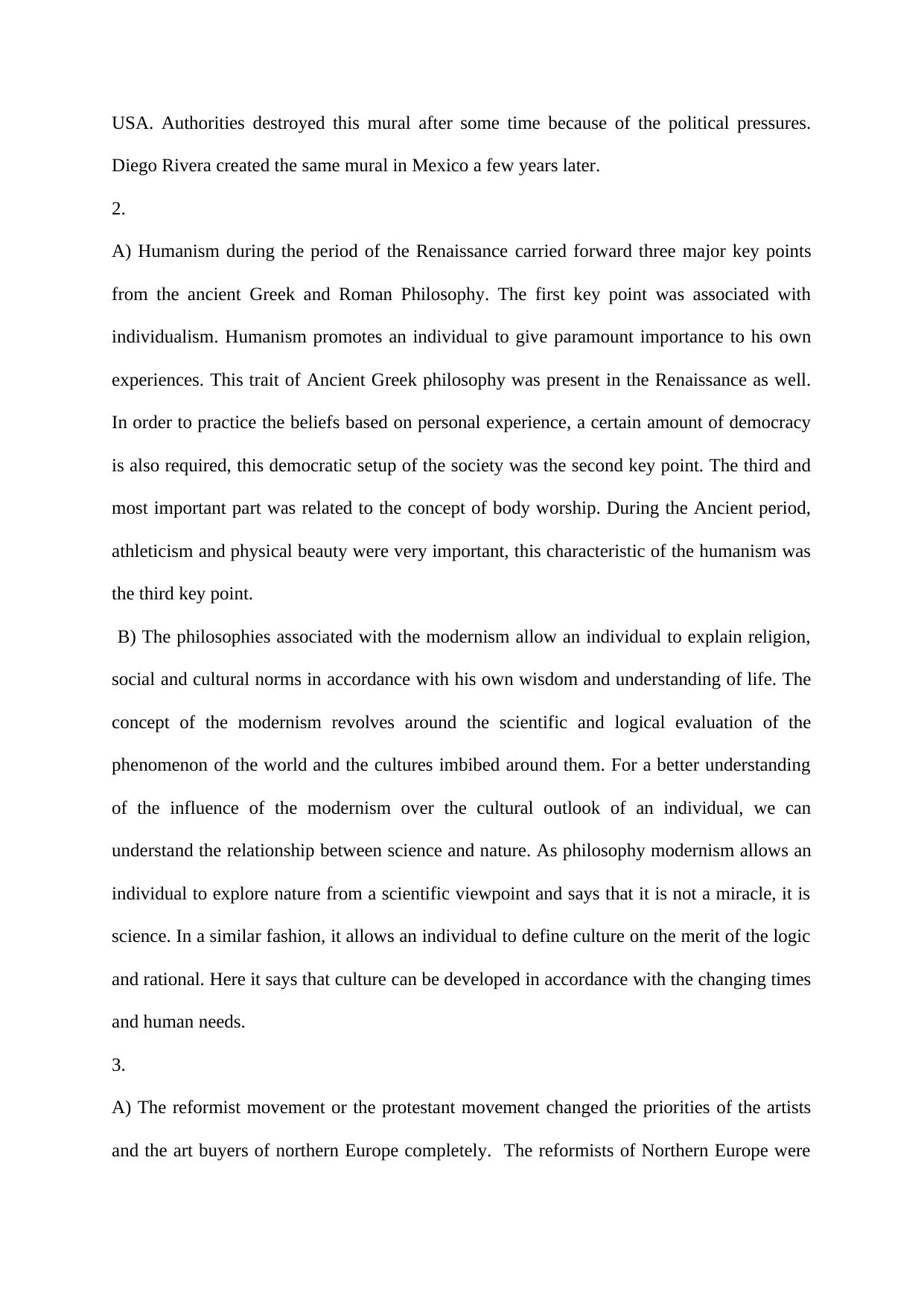
USA. Authorities destroyed this mural after some time because of the political pressures.
Diego Rivera created the same mural in Mexico a few years later.
2.
A) Humanism during the period of the Renaissance carried forward three major key points
from the ancient Greek and Roman Philosophy. The first key point was associated with
individualism. Humanism promotes an individual to give paramount importance to his own
experiences. This trait of Ancient Greek philosophy was present in the Renaissance as well.
In order to practice the beliefs based on personal experience, a certain amount of democracy
is also required, this democratic setup of the society was the second key point. The third and
most important part was related to the concept of body worship. During the Ancient period,
athleticism and physical beauty were very important, this characteristic of the humanism was
the third key point.
B) The philosophies associated with the modernism allow an individual to explain religion,
social and cultural norms in accordance with his own wisdom and understanding of life. The
concept of the modernism revolves around the scientific and logical evaluation of the
phenomenon of the world and the cultures imbibed around them. For a better understanding
of the influence of the modernism over the cultural outlook of an individual, we can
understand the relationship between science and nature. As philosophy modernism allows an
individual to explore nature from a scientific viewpoint and says that it is not a miracle, it is
science. In a similar fashion, it allows an individual to define culture on the merit of the logic
and rational. Here it says that culture can be developed in accordance with the changing times
and human needs.
3.
A) The reformist movement or the protestant movement changed the priorities of the artists
and the art buyers of northern Europe completely. The reformists of Northern Europe were
Diego Rivera created the same mural in Mexico a few years later.
2.
A) Humanism during the period of the Renaissance carried forward three major key points
from the ancient Greek and Roman Philosophy. The first key point was associated with
individualism. Humanism promotes an individual to give paramount importance to his own
experiences. This trait of Ancient Greek philosophy was present in the Renaissance as well.
In order to practice the beliefs based on personal experience, a certain amount of democracy
is also required, this democratic setup of the society was the second key point. The third and
most important part was related to the concept of body worship. During the Ancient period,
athleticism and physical beauty were very important, this characteristic of the humanism was
the third key point.
B) The philosophies associated with the modernism allow an individual to explain religion,
social and cultural norms in accordance with his own wisdom and understanding of life. The
concept of the modernism revolves around the scientific and logical evaluation of the
phenomenon of the world and the cultures imbibed around them. For a better understanding
of the influence of the modernism over the cultural outlook of an individual, we can
understand the relationship between science and nature. As philosophy modernism allows an
individual to explore nature from a scientific viewpoint and says that it is not a miracle, it is
science. In a similar fashion, it allows an individual to define culture on the merit of the logic
and rational. Here it says that culture can be developed in accordance with the changing times
and human needs.
3.
A) The reformist movement or the protestant movement changed the priorities of the artists
and the art buyers of northern Europe completely. The reformists of Northern Europe were
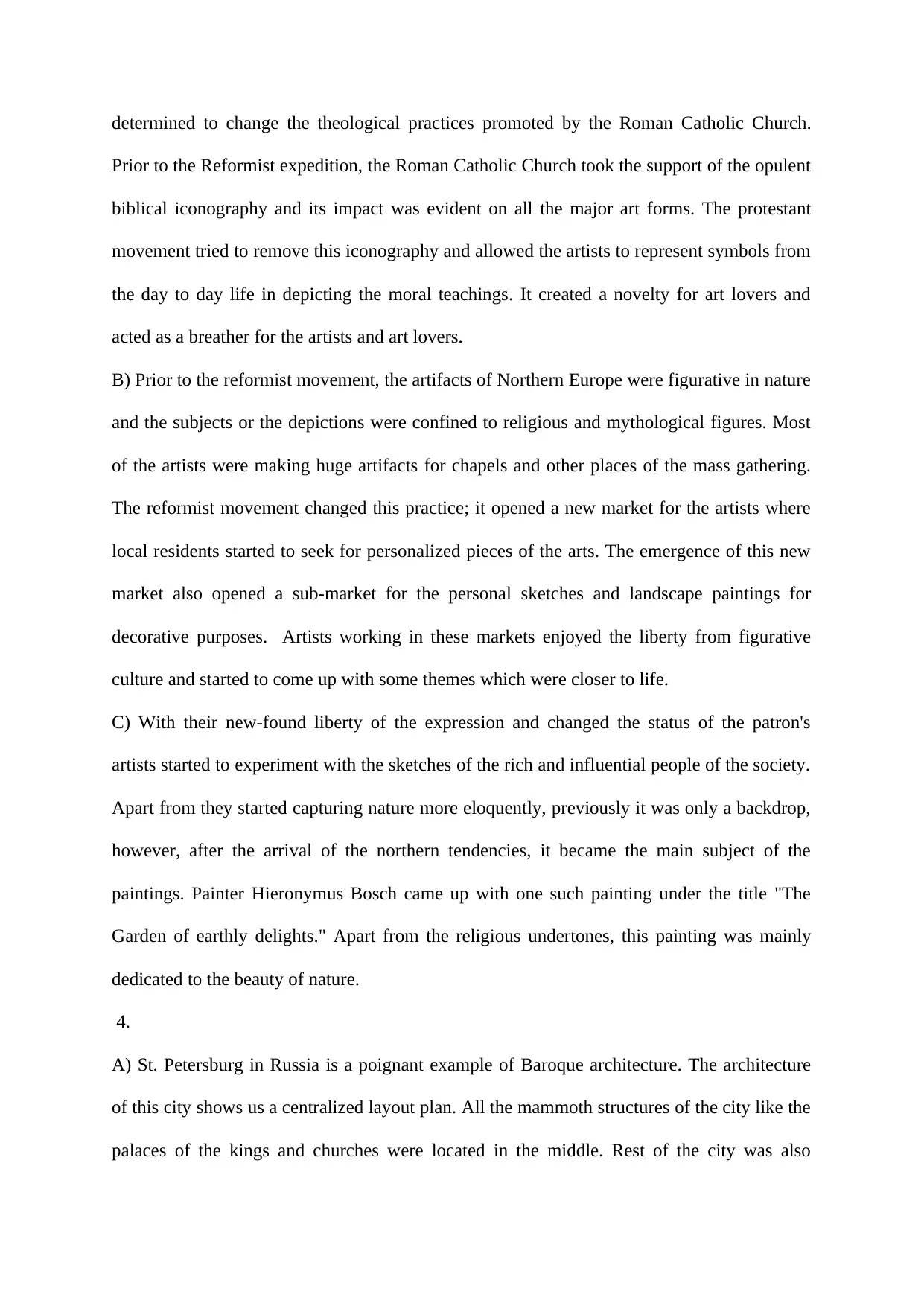
determined to change the theological practices promoted by the Roman Catholic Church.
Prior to the Reformist expedition, the Roman Catholic Church took the support of the opulent
biblical iconography and its impact was evident on all the major art forms. The protestant
movement tried to remove this iconography and allowed the artists to represent symbols from
the day to day life in depicting the moral teachings. It created a novelty for art lovers and
acted as a breather for the artists and art lovers.
B) Prior to the reformist movement, the artifacts of Northern Europe were figurative in nature
and the subjects or the depictions were confined to religious and mythological figures. Most
of the artists were making huge artifacts for chapels and other places of the mass gathering.
The reformist movement changed this practice; it opened a new market for the artists where
local residents started to seek for personalized pieces of the arts. The emergence of this new
market also opened a sub-market for the personal sketches and landscape paintings for
decorative purposes. Artists working in these markets enjoyed the liberty from figurative
culture and started to come up with some themes which were closer to life.
C) With their new-found liberty of the expression and changed the status of the patron's
artists started to experiment with the sketches of the rich and influential people of the society.
Apart from they started capturing nature more eloquently, previously it was only a backdrop,
however, after the arrival of the northern tendencies, it became the main subject of the
paintings. Painter Hieronymus Bosch came up with one such painting under the title "The
Garden of earthly delights." Apart from the religious undertones, this painting was mainly
dedicated to the beauty of nature.
4.
A) St. Petersburg in Russia is a poignant example of Baroque architecture. The architecture
of this city shows us a centralized layout plan. All the mammoth structures of the city like the
palaces of the kings and churches were located in the middle. Rest of the city was also
Prior to the Reformist expedition, the Roman Catholic Church took the support of the opulent
biblical iconography and its impact was evident on all the major art forms. The protestant
movement tried to remove this iconography and allowed the artists to represent symbols from
the day to day life in depicting the moral teachings. It created a novelty for art lovers and
acted as a breather for the artists and art lovers.
B) Prior to the reformist movement, the artifacts of Northern Europe were figurative in nature
and the subjects or the depictions were confined to religious and mythological figures. Most
of the artists were making huge artifacts for chapels and other places of the mass gathering.
The reformist movement changed this practice; it opened a new market for the artists where
local residents started to seek for personalized pieces of the arts. The emergence of this new
market also opened a sub-market for the personal sketches and landscape paintings for
decorative purposes. Artists working in these markets enjoyed the liberty from figurative
culture and started to come up with some themes which were closer to life.
C) With their new-found liberty of the expression and changed the status of the patron's
artists started to experiment with the sketches of the rich and influential people of the society.
Apart from they started capturing nature more eloquently, previously it was only a backdrop,
however, after the arrival of the northern tendencies, it became the main subject of the
paintings. Painter Hieronymus Bosch came up with one such painting under the title "The
Garden of earthly delights." Apart from the religious undertones, this painting was mainly
dedicated to the beauty of nature.
4.
A) St. Petersburg in Russia is a poignant example of Baroque architecture. The architecture
of this city shows us a centralized layout plan. All the mammoth structures of the city like the
palaces of the kings and churches were located in the middle. Rest of the city was also
⊘ This is a preview!⊘
Do you want full access?
Subscribe today to unlock all pages.

Trusted by 1+ million students worldwide

following a class base structure where influential people in the society we're living in the core
circle and common people were living on the periphery. Kings and representative of the
Roman Catholic Church often prefer to display absolutism and the Baroque architecture of
the St. Petersburg was also following the same structure.
B) The "Late Baroque Period" or the "Rococo" period of the art evolution was highly
influenced by the rich and wealthy people of the society. Many paintings and work of the arts
belonging to that era give us an undertone of the personal stories imbibed in the mythological
themes approved by the Roman Catholic Church. Broadly there were two types of influences,
some artists tried to add a social commentary by adding symbols in the backdrops of the
mythological themes. Some of the artists even painted for the personal delights of rich and
wealthy people.
5.
The concept of the "new way of looking" demonstrates the beginning of the impressionism in
modern art. The art pieces of the era of the Renaissance were more exuberant in capturing
the motion of the subjects; their focus was more on the expressions and the movements of the
subject. Monet and Cezanne, on the other hand, were more prolific in capturing the changing
colors of nature. Their style influenced a breed of the painter of that era and a new genre
under the name of Impressionism came into existence. Claude Monte’s Sunrise is a
prominent example in the genre of impressionism. “Lavacourt under the Snow” made by
Monet is another painting that sets the benchmark of expressions for that era.
5.
Response to the surroundings: - The artists working under the style of “ new way at looking
at it” depicted the backgrounds of their paintings more prominently. This we can see in the
circle and common people were living on the periphery. Kings and representative of the
Roman Catholic Church often prefer to display absolutism and the Baroque architecture of
the St. Petersburg was also following the same structure.
B) The "Late Baroque Period" or the "Rococo" period of the art evolution was highly
influenced by the rich and wealthy people of the society. Many paintings and work of the arts
belonging to that era give us an undertone of the personal stories imbibed in the mythological
themes approved by the Roman Catholic Church. Broadly there were two types of influences,
some artists tried to add a social commentary by adding symbols in the backdrops of the
mythological themes. Some of the artists even painted for the personal delights of rich and
wealthy people.
5.
The concept of the "new way of looking" demonstrates the beginning of the impressionism in
modern art. The art pieces of the era of the Renaissance were more exuberant in capturing
the motion of the subjects; their focus was more on the expressions and the movements of the
subject. Monet and Cezanne, on the other hand, were more prolific in capturing the changing
colors of nature. Their style influenced a breed of the painter of that era and a new genre
under the name of Impressionism came into existence. Claude Monte’s Sunrise is a
prominent example in the genre of impressionism. “Lavacourt under the Snow” made by
Monet is another painting that sets the benchmark of expressions for that era.
5.
Response to the surroundings: - The artists working under the style of “ new way at looking
at it” depicted the backgrounds of their paintings more prominently. This we can see in the
Paraphrase This Document
Need a fresh take? Get an instant paraphrase of this document with our AI Paraphraser
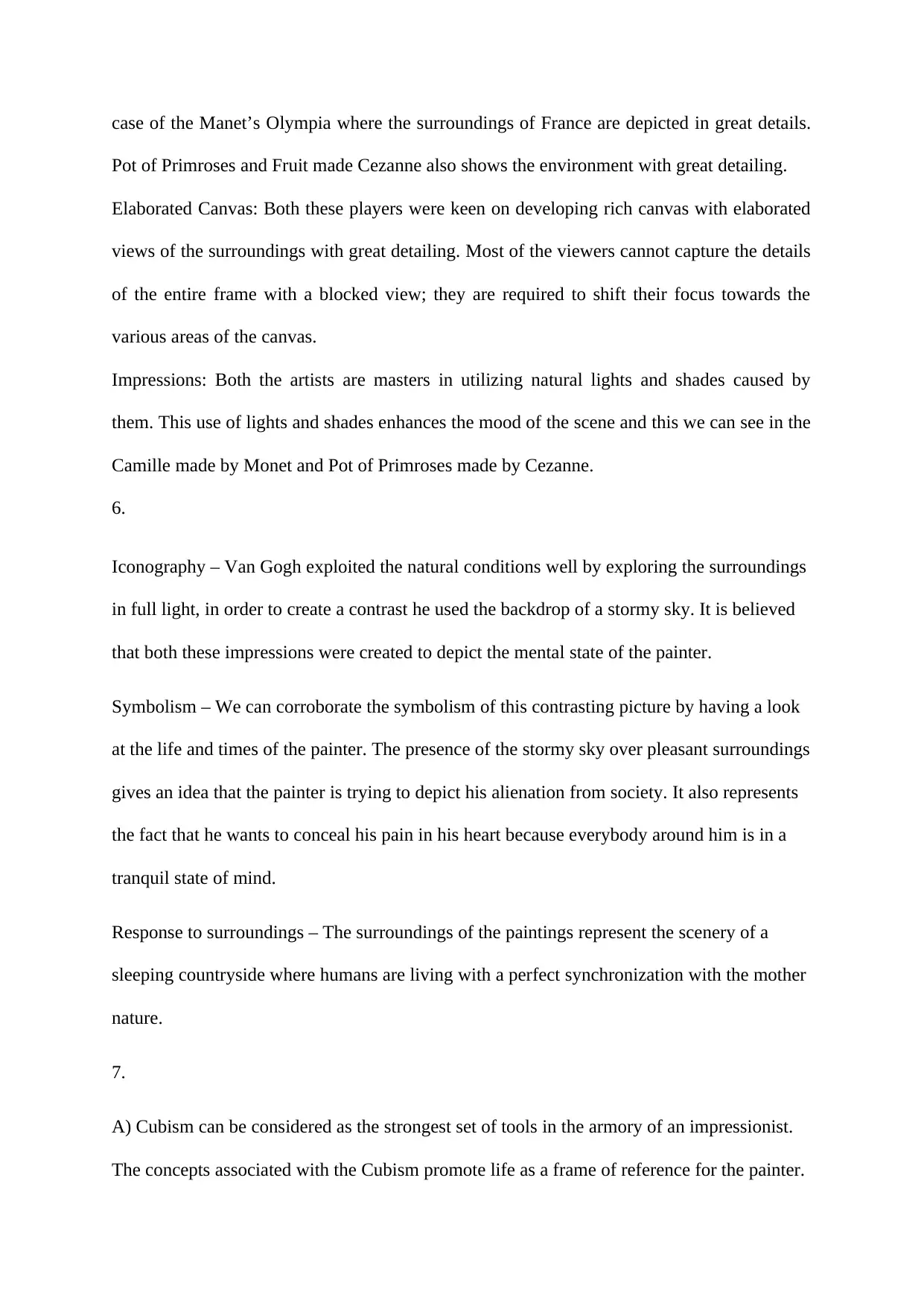
case of the Manet’s Olympia where the surroundings of France are depicted in great details.
Pot of Primroses and Fruit made Cezanne also shows the environment with great detailing.
Elaborated Canvas: Both these players were keen on developing rich canvas with elaborated
views of the surroundings with great detailing. Most of the viewers cannot capture the details
of the entire frame with a blocked view; they are required to shift their focus towards the
various areas of the canvas.
Impressions: Both the artists are masters in utilizing natural lights and shades caused by
them. This use of lights and shades enhances the mood of the scene and this we can see in the
Camille made by Monet and Pot of Primroses made by Cezanne.
6.
Iconography – Van Gogh exploited the natural conditions well by exploring the surroundings
in full light, in order to create a contrast he used the backdrop of a stormy sky. It is believed
that both these impressions were created to depict the mental state of the painter.
Symbolism – We can corroborate the symbolism of this contrasting picture by having a look
at the life and times of the painter. The presence of the stormy sky over pleasant surroundings
gives an idea that the painter is trying to depict his alienation from society. It also represents
the fact that he wants to conceal his pain in his heart because everybody around him is in a
tranquil state of mind.
Response to surroundings – The surroundings of the paintings represent the scenery of a
sleeping countryside where humans are living with a perfect synchronization with the mother
nature.
7.
A) Cubism can be considered as the strongest set of tools in the armory of an impressionist.
The concepts associated with the Cubism promote life as a frame of reference for the painter.
Pot of Primroses and Fruit made Cezanne also shows the environment with great detailing.
Elaborated Canvas: Both these players were keen on developing rich canvas with elaborated
views of the surroundings with great detailing. Most of the viewers cannot capture the details
of the entire frame with a blocked view; they are required to shift their focus towards the
various areas of the canvas.
Impressions: Both the artists are masters in utilizing natural lights and shades caused by
them. This use of lights and shades enhances the mood of the scene and this we can see in the
Camille made by Monet and Pot of Primroses made by Cezanne.
6.
Iconography – Van Gogh exploited the natural conditions well by exploring the surroundings
in full light, in order to create a contrast he used the backdrop of a stormy sky. It is believed
that both these impressions were created to depict the mental state of the painter.
Symbolism – We can corroborate the symbolism of this contrasting picture by having a look
at the life and times of the painter. The presence of the stormy sky over pleasant surroundings
gives an idea that the painter is trying to depict his alienation from society. It also represents
the fact that he wants to conceal his pain in his heart because everybody around him is in a
tranquil state of mind.
Response to surroundings – The surroundings of the paintings represent the scenery of a
sleeping countryside where humans are living with a perfect synchronization with the mother
nature.
7.
A) Cubism can be considered as the strongest set of tools in the armory of an impressionist.
The concepts associated with the Cubism promote life as a frame of reference for the painter.

It also allows them to experiment with the colors and textures while depicting certain familiar
objects. In other words, we can say that cubism attracts the fancy of artist and viewers
because it allows them to break the monotony of life and present it in a surreal way. In order
to add exactness in the expression, it also allows an artist to add text in the picture as well.
B.
The creation of Mjölnir, Hans Schweitzer, the painting under the title "Our Last Hope—
Hitler" is known to create political propaganda, where they depicted Hitler as the savior of
the German population. However, the inhuman ways of Hitler were not acceptable to a major
chunk of the German population as well. This painting was aimed to create a positive image
of Hitler among the masses. Art has the power to influence the masses; it was more or less
like a glorified sketch of Hitler that was presented with the help of this painting.
8
a) The emergence of abstract expressionism came in as a breather for the artists of the
modern era. With the help of this art, form artists removed the barriers of the decorative
backgrounds and elaborated. In the terms of the journey of an artist, while creating an
artwork, we can also make a statement that abstract expressionism created an opportunity for
the artists where they can internalize their observations and feelings about the world and later
on express them ahead of the boundaries of any given art form.
Factors like symmetry and aesthetics or grandeur of the paintings took the back seat and
simplicity and randomness of the curves, brush strokes and new color palates became the
main tools. The arrival of the abstract impressionism broke the monotony of grand visuals
and changed the conventional definitions of art forms to set a new culture of expressions.
objects. In other words, we can say that cubism attracts the fancy of artist and viewers
because it allows them to break the monotony of life and present it in a surreal way. In order
to add exactness in the expression, it also allows an artist to add text in the picture as well.
B.
The creation of Mjölnir, Hans Schweitzer, the painting under the title "Our Last Hope—
Hitler" is known to create political propaganda, where they depicted Hitler as the savior of
the German population. However, the inhuman ways of Hitler were not acceptable to a major
chunk of the German population as well. This painting was aimed to create a positive image
of Hitler among the masses. Art has the power to influence the masses; it was more or less
like a glorified sketch of Hitler that was presented with the help of this painting.
8
a) The emergence of abstract expressionism came in as a breather for the artists of the
modern era. With the help of this art, form artists removed the barriers of the decorative
backgrounds and elaborated. In the terms of the journey of an artist, while creating an
artwork, we can also make a statement that abstract expressionism created an opportunity for
the artists where they can internalize their observations and feelings about the world and later
on express them ahead of the boundaries of any given art form.
Factors like symmetry and aesthetics or grandeur of the paintings took the back seat and
simplicity and randomness of the curves, brush strokes and new color palates became the
main tools. The arrival of the abstract impressionism broke the monotony of grand visuals
and changed the conventional definitions of art forms to set a new culture of expressions.
⊘ This is a preview!⊘
Do you want full access?
Subscribe today to unlock all pages.

Trusted by 1+ million students worldwide

b)
Abstract expressionism failed in creating a connection with the masses because there were
occasions when it failed in creating authentic emotions. Artists like De Kooning
Tried to set a grammar for the abstract expressionism. He created some masterpieces that
were not closer to the actual feelings of the artist. These paintings were offering a perception
for all viewers, this universalization of the message forced many artists to drift away from
this genre. As an artist, every individual wants to bare his or her heart out and abstract
impressionism was providing limited options to them.
C) Many artists experienced with certain techniques to overcome the limiting factors
associated with the abstract impressionism, these attempts gave rise to a new transitional art
form known as pop art. The culture of the consumerism created dependence on market forces
over popular art cultures. Socioeconomic structures of the society were seeking for a mass
medium to promote their special interest messages. The Bed of 1955 and many such artworks
gives us an interesting picture where the artist was working in synchronization with the
market forces and finding performance-based patronage. It was also the era when pure
abstract representation took a back seat.
d. The minimalistic style erased the pompousness of the previous styles. We can also term it
is a simplistic expression with strong roots in abstract art forms. These roots were related to
the color schemes and the selection of the lines and the curves. This style allowed an artist to
express certain internal feelings in a commercial setup and predetermined messages. The
influence of popular culture and the feedback of the masses allowed the artists to experiment
with the themes and made it a flourishing art at the turn of the previous century.
9
Abstract expressionism failed in creating a connection with the masses because there were
occasions when it failed in creating authentic emotions. Artists like De Kooning
Tried to set a grammar for the abstract expressionism. He created some masterpieces that
were not closer to the actual feelings of the artist. These paintings were offering a perception
for all viewers, this universalization of the message forced many artists to drift away from
this genre. As an artist, every individual wants to bare his or her heart out and abstract
impressionism was providing limited options to them.
C) Many artists experienced with certain techniques to overcome the limiting factors
associated with the abstract impressionism, these attempts gave rise to a new transitional art
form known as pop art. The culture of the consumerism created dependence on market forces
over popular art cultures. Socioeconomic structures of the society were seeking for a mass
medium to promote their special interest messages. The Bed of 1955 and many such artworks
gives us an interesting picture where the artist was working in synchronization with the
market forces and finding performance-based patronage. It was also the era when pure
abstract representation took a back seat.
d. The minimalistic style erased the pompousness of the previous styles. We can also term it
is a simplistic expression with strong roots in abstract art forms. These roots were related to
the color schemes and the selection of the lines and the curves. This style allowed an artist to
express certain internal feelings in a commercial setup and predetermined messages. The
influence of popular culture and the feedback of the masses allowed the artists to experiment
with the themes and made it a flourishing art at the turn of the previous century.
9
Paraphrase This Document
Need a fresh take? Get an instant paraphrase of this document with our AI Paraphraser
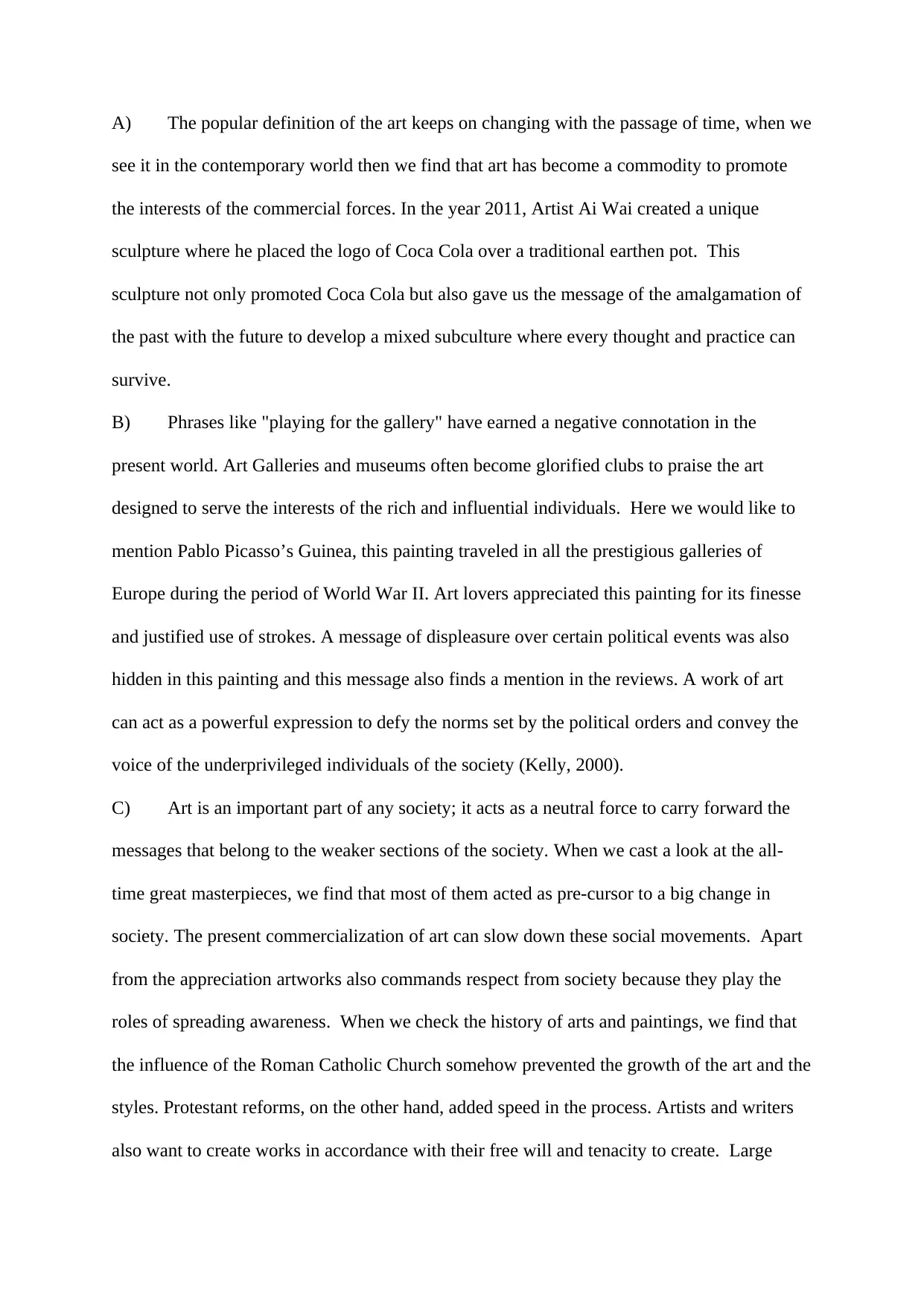
A) The popular definition of the art keeps on changing with the passage of time, when we
see it in the contemporary world then we find that art has become a commodity to promote
the interests of the commercial forces. In the year 2011, Artist Ai Wai created a unique
sculpture where he placed the logo of Coca Cola over a traditional earthen pot. This
sculpture not only promoted Coca Cola but also gave us the message of the amalgamation of
the past with the future to develop a mixed subculture where every thought and practice can
survive.
B) Phrases like "playing for the gallery" have earned a negative connotation in the
present world. Art Galleries and museums often become glorified clubs to praise the art
designed to serve the interests of the rich and influential individuals. Here we would like to
mention Pablo Picasso’s Guinea, this painting traveled in all the prestigious galleries of
Europe during the period of World War II. Art lovers appreciated this painting for its finesse
and justified use of strokes. A message of displeasure over certain political events was also
hidden in this painting and this message also finds a mention in the reviews. A work of art
can act as a powerful expression to defy the norms set by the political orders and convey the
voice of the underprivileged individuals of the society (Kelly, 2000).
C) Art is an important part of any society; it acts as a neutral force to carry forward the
messages that belong to the weaker sections of the society. When we cast a look at the all-
time great masterpieces, we find that most of them acted as pre-cursor to a big change in
society. The present commercialization of art can slow down these social movements. Apart
from the appreciation artworks also commands respect from society because they play the
roles of spreading awareness. When we check the history of arts and paintings, we find that
the influence of the Roman Catholic Church somehow prevented the growth of the art and the
styles. Protestant reforms, on the other hand, added speed in the process. Artists and writers
also want to create works in accordance with their free will and tenacity to create. Large
see it in the contemporary world then we find that art has become a commodity to promote
the interests of the commercial forces. In the year 2011, Artist Ai Wai created a unique
sculpture where he placed the logo of Coca Cola over a traditional earthen pot. This
sculpture not only promoted Coca Cola but also gave us the message of the amalgamation of
the past with the future to develop a mixed subculture where every thought and practice can
survive.
B) Phrases like "playing for the gallery" have earned a negative connotation in the
present world. Art Galleries and museums often become glorified clubs to praise the art
designed to serve the interests of the rich and influential individuals. Here we would like to
mention Pablo Picasso’s Guinea, this painting traveled in all the prestigious galleries of
Europe during the period of World War II. Art lovers appreciated this painting for its finesse
and justified use of strokes. A message of displeasure over certain political events was also
hidden in this painting and this message also finds a mention in the reviews. A work of art
can act as a powerful expression to defy the norms set by the political orders and convey the
voice of the underprivileged individuals of the society (Kelly, 2000).
C) Art is an important part of any society; it acts as a neutral force to carry forward the
messages that belong to the weaker sections of the society. When we cast a look at the all-
time great masterpieces, we find that most of them acted as pre-cursor to a big change in
society. The present commercialization of art can slow down these social movements. Apart
from the appreciation artworks also commands respect from society because they play the
roles of spreading awareness. When we check the history of arts and paintings, we find that
the influence of the Roman Catholic Church somehow prevented the growth of the art and the
styles. Protestant reforms, on the other hand, added speed in the process. Artists and writers
also want to create works in accordance with their free will and tenacity to create. Large
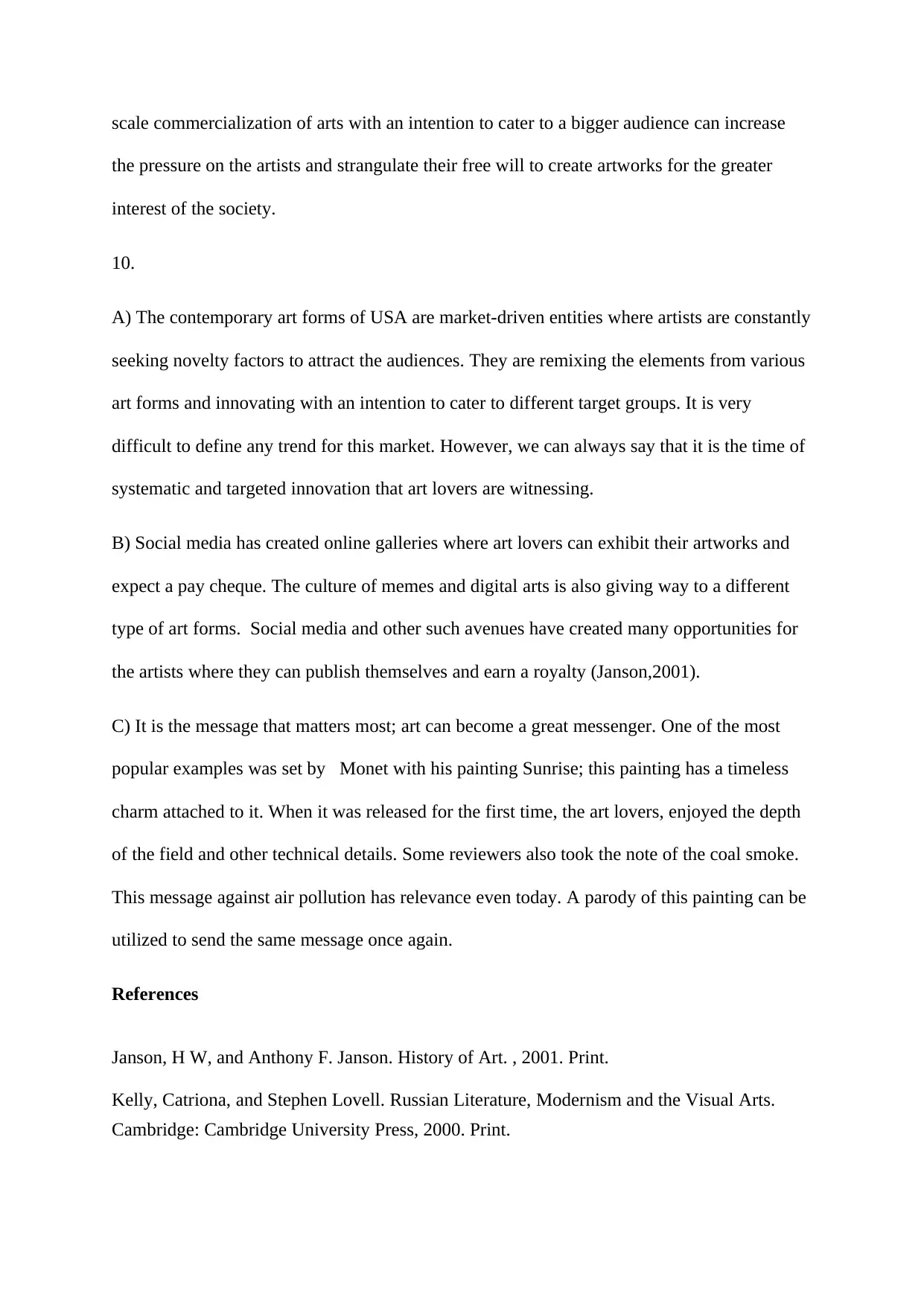
scale commercialization of arts with an intention to cater to a bigger audience can increase
the pressure on the artists and strangulate their free will to create artworks for the greater
interest of the society.
10.
A) The contemporary art forms of USA are market-driven entities where artists are constantly
seeking novelty factors to attract the audiences. They are remixing the elements from various
art forms and innovating with an intention to cater to different target groups. It is very
difficult to define any trend for this market. However, we can always say that it is the time of
systematic and targeted innovation that art lovers are witnessing.
B) Social media has created online galleries where art lovers can exhibit their artworks and
expect a pay cheque. The culture of memes and digital arts is also giving way to a different
type of art forms. Social media and other such avenues have created many opportunities for
the artists where they can publish themselves and earn a royalty (Janson,2001).
C) It is the message that matters most; art can become a great messenger. One of the most
popular examples was set by Monet with his painting Sunrise; this painting has a timeless
charm attached to it. When it was released for the first time, the art lovers, enjoyed the depth
of the field and other technical details. Some reviewers also took the note of the coal smoke.
This message against air pollution has relevance even today. A parody of this painting can be
utilized to send the same message once again.
References
Janson, H W, and Anthony F. Janson. History of Art. , 2001. Print.
Kelly, Catriona, and Stephen Lovell. Russian Literature, Modernism and the Visual Arts.
Cambridge: Cambridge University Press, 2000. Print.
the pressure on the artists and strangulate their free will to create artworks for the greater
interest of the society.
10.
A) The contemporary art forms of USA are market-driven entities where artists are constantly
seeking novelty factors to attract the audiences. They are remixing the elements from various
art forms and innovating with an intention to cater to different target groups. It is very
difficult to define any trend for this market. However, we can always say that it is the time of
systematic and targeted innovation that art lovers are witnessing.
B) Social media has created online galleries where art lovers can exhibit their artworks and
expect a pay cheque. The culture of memes and digital arts is also giving way to a different
type of art forms. Social media and other such avenues have created many opportunities for
the artists where they can publish themselves and earn a royalty (Janson,2001).
C) It is the message that matters most; art can become a great messenger. One of the most
popular examples was set by Monet with his painting Sunrise; this painting has a timeless
charm attached to it. When it was released for the first time, the art lovers, enjoyed the depth
of the field and other technical details. Some reviewers also took the note of the coal smoke.
This message against air pollution has relevance even today. A parody of this painting can be
utilized to send the same message once again.
References
Janson, H W, and Anthony F. Janson. History of Art. , 2001. Print.
Kelly, Catriona, and Stephen Lovell. Russian Literature, Modernism and the Visual Arts.
Cambridge: Cambridge University Press, 2000. Print.
⊘ This is a preview!⊘
Do you want full access?
Subscribe today to unlock all pages.

Trusted by 1+ million students worldwide

1 out of 10
Your All-in-One AI-Powered Toolkit for Academic Success.
+13062052269
info@desklib.com
Available 24*7 on WhatsApp / Email
![[object Object]](/_next/static/media/star-bottom.7253800d.svg)
Unlock your academic potential
Copyright © 2020–2025 A2Z Services. All Rights Reserved. Developed and managed by ZUCOL.